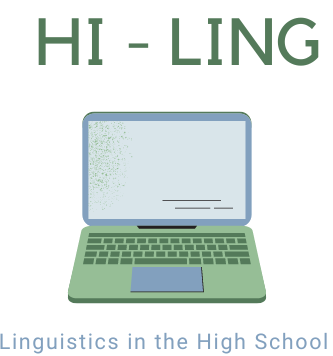HI-LING
LINGUISTICS IN THE HIGH SCHOOL

UNIT 2: VIOLATION OF MAXIMS
Introduction to Forensic Linguistics
What is this field of linguistics all about? Before we dive into this field, let’s watch this video.
https://www.youtube.com/watch?v=HlBYdiXdUa8
What happened in this video? What are the victim and the police officer trying to find out?
This is an example of what the field of forensic linguistics can look like. But what is forensic linguistics and how is it used?
Forensic linguistics is a field of study that combines the principles of linguistics and forensic science to analyze language and communication in legal contexts. It is the study or science of solving crimes by using scientific knowledge or methods. It contains analyzing written and spoken language in legal contexts.
We have seen in the Youtube clip above that the officer and the victim tried to find the identity of the murderer by his voice. But what do actual forensic linguists do?
Some forensic linguists examine written documents in order to determine the authenticity or the author of the document. This could be messages, emails, letters, all of which can be critical in cases involving threats, cyberbullying, wills and testimonies and so on. Forensic linguists scrutinize various linguistic elements, such as vocabulary, grammar, and syntax, along with spelling errors and punctuation patterns to provide insights into an author's background or origin. But one of the key areas in the field of forensic linguistics is forensic phonetics which contains the analysis of spoken language such as conversations that have been recorded, witness testimonies, or even singing as we have seen in the video and more. By doing this, they can help to reveal the identity of the speaker or to even uncover hidden meanings or messages.
The human voice is a complex and highly variable signal that contains information about the speaker's identity, emotions, and intentions. We can use a recording of a person's voice for various applications, such as speech recognition, speaker identification, forensic phonetics and emotional analysis. In this context, the voice can serve as a valuable tool for law enforcement and legal professionals to identify suspects, analyze evidence, and solve crimes. The voice is produced by the interaction of the respiratory, phonatory, and articulatory systems, which generate and shape the sound waves. It is influenced by individual differences, such as age, gender, language, and dialect. Various methods, including acoustic analysis and physiological measurement, are employed to study the voice. It's worth noting that with advancements in technology, including the use of AI, voice disguises have become more sophisticated, making the identification of voices a challenging task in some cases.
Why is forensic linguistics so important?
To sum up, forensic linguistics is important for several reasons. Firstly, as we have learned, it can provide valuable evidence in criminal investigations. By analyzing language patterns and linguistic features, forensic linguists can help identify suspects, link individuals to specific texts or messages, and provide insights into their background or intentions. This can be particularly useful in cases involving threats, harassment, fraud, or other forms of communication-related crimes.
Secondly, forensic linguistics can help determine the authenticity or authorship of disputed documents. By examining the linguistic characteristics of a text, linguists can assess whether it was written by a particular individual or if it matches the writing style of a known author. This can be crucial in cases involving forged documents, plagiarism, or disputed contracts.
Furthermore, forensic linguistics can contribute to the protection of individuals' rights. By analyzing language use in legal contexts, linguists can identify potential biases, misunderstandings, or linguistic barriers that may affect the fairness of legal proceedings. This can help ensure that justice is served and that individuals are not wrongly accused or convicted based on misinterpretations of language.
We have introduced you to various parts of forensic linguistics. In the upcoming lessons we will focus only on forensic phonetic. We will go through each of these following subjects:
-
Speaker Profiling
-
Speaker Comparison
-
Voice Parades
-
Stylometry
As we go through these concepts we will follow Detective X on the case of the stolen chocolate recipe from the Lindt factory, and their next adventure at the cheese vault.